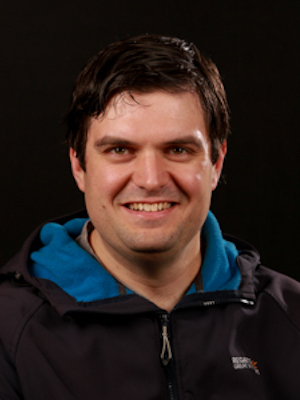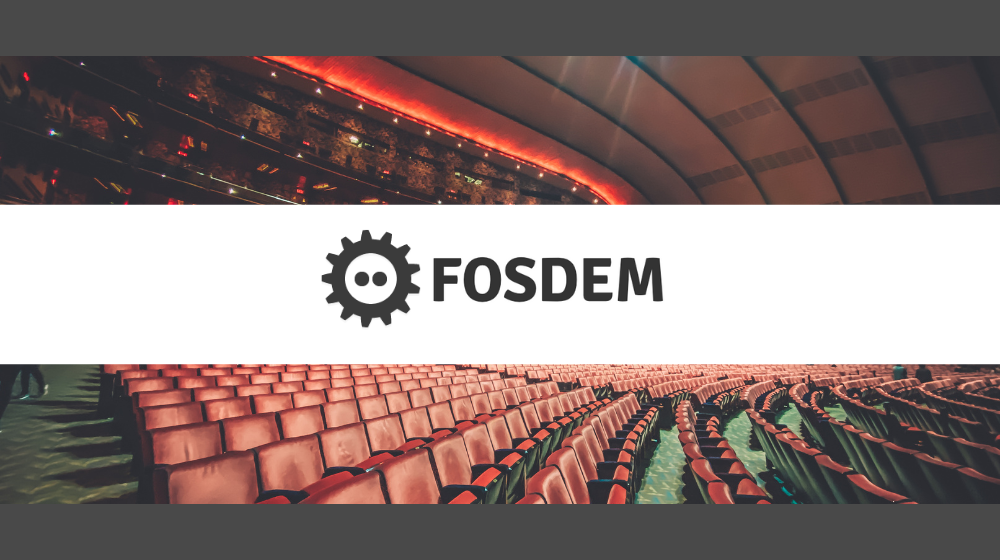Introducing FOSDEM
For those who aren’t familiar with it, FOSDEM, or the Free and Open Source Developers European Meeting, is one of, if not the biggest, Free and Open Source conference in the world. It takes place at the Université Libre de Bruxelles Solbosch campus in Brussels, Belgium, on the first weekend of February every year and attracts over 8000 attendees. It is completely free to attend, there’s not even a registration process and the whole thing is run by volunteers.
Deciding what to see
As there are so many talks, it is simply impossible to see everything you want. Sometimes rooms fill up and it isn’t possible to get to some talks, and sometimes two back to back talks you want to see are on opposite sides of the campus. It definitely helps to plan what you are going to see and at least have one backup option during each time slot. For this, I used the FOSDEM Companion app which has an offline copy of the schedule, lets you mark which talks you’re interested in and alerts you when they’re about to start.
Open Source Infrastructure and Volunteers Running the Conference
Every FOSDEM talk is recorded using their own open source video capture solution (if this interests you, see this talk from the infrastructure team). Talks were also streamed live and there were also several remote only tracks, including the Research track which featured talks by SSI Fellows Rachael Ainsworth and Saranjeet Kaur Bhogal. Not only was this a great way to allow online participation, but it also gave people attending FOSDEM in person a way to see a talk live when the room was full or they couldn’t get across the campus fast enough.
The whole conference would not have been possible without a small army of volunteers who do everything from running the video streams and network infrastructure, to setting up rooms, dealing with lost property and running a help desk. I was particularly impressed to see several people whom I knew from when they were students and had come on student trips to FOSDEM now returning as volunteers and sometimes with support from their graduate employers.
My Highlights from the talks I saw
I could probably write several blog posts about all the great talks I saw and several more about the talks that I didn’t see during FOSDEM. Here are just a few highlights that I think might be interesting to readers of this blog.
Consulting for digital humanists
This talk by Marie Dubremetz covered the culture shock involved with getting humanities researchers working with software developers and computer scientists. Many of the issues encountered sounded like they’d be very familiar to many research software engineers. At times it was difficult to find a common language and it shows the importance of software engineers asking the right questions of people they build software for. There are also big cultural differences with most humanities researchers being Windows or Mac users, being interested in answering a research question, not developing a technology. Humanities researchers are slightly more likely to be female than male whereas software engineers are still overwhelmingly male.
Tackling Disinformation using Open Source Software
This was a great talk by Hervé from Openfactor about tracking down and tackling disinformation online using open source tools. The speaker described himself as a techy but not a coder and made this clear by being one of the few people at the conference wearing a suit and stating “I'm not a coder as you can see". This work focussed on identifying the key person behind Qactus, often dubbed the French QAnon.
The other kind of Software Sustainability
One theme I hadn’t seen discussed much at previous FOSDEMs was environmental sustainability and the impact of computation on the environment. I attended four talks that covered this subject.
The first was “Open source in environmental sustainability” by Tobias Augspurger which discussed:
- Several open source tools that are helping in sustainability including:
Biodiversity and satellite image analysis tools
Pvlib for designing solar panel arrays
Pypsa for simulating power grids.
- The problem of academic projects where code is thrown onto Git Hub but isn’t really reusable.
- How openness is key to traceability in environmental modelling, we shouldn’t blindly trust somebody else’s model and doing so can propagate uncertainty and errors from one model to another.
The second and third talks were by Chris Adams from the Green Web Foundation, the first was in the Sovereign Cloud track on “Responsible clouds and the green web triangle” and the second in the Energy track on “Getting to a Fossil Free Internet by 2030”. In these, he talked about:
- The need to make code more efficient to reduce energy consumption
- How the Firefox Energy Profiler (discussed in another talk that I didn’t make it to) can help developers target their optimisations.
- Moving performance critical parts of programs to compiled languages to improve performance and reduce computational overheads.
- Reducing the overall consumption of computing
- The Kepler project’s carbon intensity measurement tool for Kubernetes
- Timeshifting when computation happens to when the grid emissions are lower
- Carbon aware routing protocols that minimise carbon emissions instead of performance
- To meet the goal of being net zero by 2050 we need to halve IT emissions by 2030. Organisations that are serious about doing this will need interim targets as soon as 2025 to achieve that. They’ll need to start measuring the impact of their computing very soon to determine if they’ve met their 2025 targets.
- Creating environmentally aware design patterns for software developers to follow.
- A mention of the Environment Variables podcast from the Green Software Foundation. I subscribed to this after the conference and it has taught me a lot more about this growing movement. It was part of my inspiration behind proposing the Climate Aware Task Scheduler idea at Collaborations Workshop in May.
The final talk on this topic was “Combatting software-driven environmental harm with free software.” by Joseph De Veaugh-Geiss. He talked about:
- How the ICT sector represents 1.8 to 3.9% of global greenhouse gas emissions and by 2050 this will be 30% if nothing changes.
- Improving the efficiency of software can reduce the amount of electricity it uses.
Comparing a popular proprietary word processor with a popular open source one, the open source one used four times less energy performing the same task. Millions or even billions of people use word processors daily, a small change in the software might have big impacts.
- A lot of the ICT sector’s emissions come from the production of hardware, not from the operation of it, this is especially true with mobile devices.
Cited the example of an iPhone 7 where 78% of the lifetime greenhouse gases came from its production.
We can have a big impact by not making functional hardware obsolete so quickly and open source software often does a better job at supporting older hardware.
- There are now mechanisms for certifying the sustainability of software.
The talk mentioned the KDE Project being granted the German Blueangel environmental certification.
This was achieved through resource efficiency and transparency of the energy measurements, running on older hardware, long term support and user autonomy to disable unwanted features.
There were several other talks in the Energy track that I didn’t get a chance to see around this subject, but I’d suggest anybody interested in it have a look at these on the Energy track page. In particular, the talks on Carbon Intensity Aware Scheduling in Kubernetes, Green Software Engineering and the Firefox Power Profiler all looked very interesting.
Other Talks
There were many other great talks that I saw at FOSDEM that I simply don’t have time to write about in detail. But here are links to some of them:
- Similarity Detection in Online Integrity, by Alberto Massidda from Meta. This covered a set of techniques used to detect images to be blocked such as child exploitation, revenge porn and terrorism. They ranged from some very computationally simple techniques up to deep learning models.
- I attended two talks [1, 2] about how to support FIDO hardware tokens such as Yubikeys and Titan Security Keys in your applications.
- Openstreetmap: open your emergency eyes, by Nicole Martinelli covered using OpenStreetMap to plan emergency responses. She focused on the example of heatwaves and efforts to tag “cool centres” where members of the public could shelter from the heat.
- Bizarre and Unusual Uses of DNS by Peter Lowe was a great look at all kinds of weird and wonderful (ab)uses for the DNS protocol. Including a reverse polish notation calculator, geocaching via DNS, a text adventure game, tunnels and VPNs over DNS and even filesystem over DNS.
- The PolyVent FLOSS ventilator by Robert Read about an open source ventilator design and how it was being built using a Unix-like philosophy with modular components that “do one thing well” that would facilitate training people to understand and repair the device.
- Can Genode on the PinePhone question the notion of a smartphone? By Norman Feske presented work to use the highly secure Genode operating system on the open source Pinephone to create a phone experience where the user has complete control over what it runs.
- Practical Computerized Home Automation covering 10 years of the presenter’s experiences with various home automation technologies that he’s deployed in his house and thoughts on non-technical people using and accepting these.
- There was a launch of an open source pico balloon called TinyGlobo. Unfortunately, I only found out about this after the conference.
- Celebrating 25 years of Open Source: Past, Present, and Future a keynote talk by Nick Vidal set out the history of the Open Source movement and gave an overview of how we got to where we are and future challenges and opportunities for open source.
- Making the world a better place through open source collaboration by Gabriele Columbro discussed how popular and ubiquitous open source has become and how it now underpins large amounts of the economy.
- Free culture CV by Pablo Hinojosa Nava presented the idea of trying to build free culture CVs that reflect people’s contributions to free culture projects. This includes open source software contributions and non-code contributions such as Wikipedia, OpenStreetMap, translation and documentation efforts.
There were many more that I didn’t get to see and that I’m gradually working through watching the recordings of. Some recordings are up on the FOSDEM YouTube channel and all of them are available via the FOSDEM 2023 website.
FOSDEM 2024
If you’re thinking of attending FOSDEM in 2024 the dates have been announced already as the 3rd and 4th of February 2024 in the same location. Keep an eye on https://fosdem.org/2024/ for updates.


